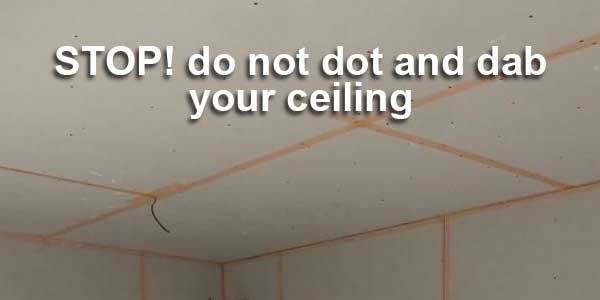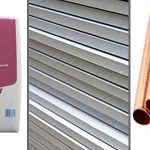When renovating a property or making improvements. One area you may consider updating is your ceilings. Basically, you will want your ceilings to look just as new and fresh as your walls.
Old plasterboard ceilings or lathe and plaster ceilings can both start to look tired overtime. They can also become damaged or weakened. For example, cracks can form, and areas of the plaster can blow. In the worst cases, they can even be in danger of collapsing entirely (this is a worst-case scenario).
If you do choose to replace your ceiling, you have several options available. One of these options is to install plasterboards on top of the existing surface.

Before you fit your plasterboards you may be wondering the best way to do this. For example, could you choose to dot and dab over the existing ceiling? Or would this be a terrible idea?
If you’re considering using dot and dab on your ceiling, then stop! this is not the right approach. The ceiling comes under immense strain from gravity and the weight of the boards. This means you must fit the plasterboards securely using screws.
Dot and dab adhesive can give an excellent fixing on walls, but it is definitely not appropriate for ceilings. The bond would be too weak, meaning it could become dangerous, and the plasterboards could fall. Therefore, you have two options to consider:
- Fit plasterboards directly over the existing ceiling using screws
- Rip down the existing ceiling and start from scratch
How you approach either of these options will depend on the condition of the ceiling. So, you will need to assess this before you begin.
Why Should You Screw and Not Dot and Dab?
One of the most common options of fitting plasterboards to walls is using dot and dab. However, the ceiling is completely different to walls because they are exposed to forces such as gravity and movement from above.
Dot and dab involves using a drywall adhesive on an existing surface. When mixed correctly, it forms an extremely strong bond which makes it ideal for use when boarding walls.
The boards can be moved into position before the adhesive dries, and once it goes off it creates a solid bond. There are minimal forces involved, which ensures that the plasterboards are set in position and will not fall away.
The problem with trying to dot and dab a ceiling is the ability to create a solid bond. Even if you decided to use support props to create an upward pressure allowing the dabs to dry, the bond would still not be enough. The adhesive relies on suction and if this is lost the dabs will pop off the ceiling and the board will drop.
This could cause serious harm to anyone below. It would at least cause a lot of mess and hassle.
Locating joists
Therefore, the best option is to screw the plasterboards to the existing joists. In most cases it is very easy to locate joists. You can use a bradawl or a screw. Since you’re over boarding you could even break a hole in the ceiling and find joists with your hands. Following this it is likely that joists will be around 400mm apart, so you can use a tape measure and a bradawl or screw to find the next one
Joists will run at a 90-degree angle to supporting walls. Supporting walls are solid internal walls, so this will give you an idea of the direction that the joists run in.
If the ceiling is upstairs, you could also access the loft and measure the gaps between the joists. Or from downstairs, you could lift the floorboards in the room above.
Another option could be to remove the ceiling completely. This would depend on the damage, but you should also consider the amount of mess this is likely to cause.
Once the joists have been located, you can then proceed to fit the plasterboards in place using 38mm plasterboard screws every 150mm. This will ensure that the plasterboards are fitted securely in place.
Over boarding a plasterboard ceiling
If your existing ceiling is plasterboard, the easiest option will nearly always be over boarding. If it has severe damage, then you might need to remove the existing ceiling, but in most cases you can overboard.
By removing the existing ceiling, you’ll be able to locate the joists easily, but this might be the only advantage of doing it. In most cases it will just add extra work and removing the old ceiling will be messy. Furthermore, the debris will also need to be disposed of correctly.
Over boarding an existing plasterboard ceiling is the best option in the vast majority of cases. All you need to do is ensure that the plasterboards are secured to the existing joists. You will just need to use slightly longer screws to ensure you get a good fixing into the joists. Once fitted, you will have a ceiling that is secure and ready to skim.
Over boarding an Existing Lath and Plaster Ceiling
Lath and plaster is commonly found in old properties. It is made of thin strips of baton that are secured to the joists with a lime render applied over the top of them.
As it is usually old, the batons can often deteriorate. Along with this, the plaster can become dry, brittle, and delicate, which can result in the entire ceiling becoming weaker. This can increase the risk of it falling. It can also suffer from cracking and even bulging, which could be a sign of an additional problem such as damp or moisture ingress.
However, one of the biggest issues with lath and plaster is the mess. Once you begin removing it, it can create a lot of mess (far more than plasterboard). This will include huge amounts of rubble and waste, plus thick black dust.
Therefore, if the lath and plaster ceiling is in reasonable condition, it definitely makes sense to board on top of it.
Again, you would need to locate the joists to secure the plasterboard in place. but this is the quickest and easiest option of creating a new ceiling with minimal hassle. Lath and plaster also provides excellent soundproofing. So, when plasterboard is fitted on top it can help to reduce noise between rooms.
Conclusion
In conclusion, it is definitely not advised to dot and dab an existing ceiling, because this can prove dangerous, and it can cause a lot of damage. This is because the drywall adhesive will not form a strong bond.
Therefore, you should look to fit plasterboard over your existing ceiling with mechanical fixings (screws). This will ensure a solid and securely fitted ceiling.
Whether it’s plasterboard or lath and plaster you are covering, it will reduce costs, mess, effort, and it is far quicker.




